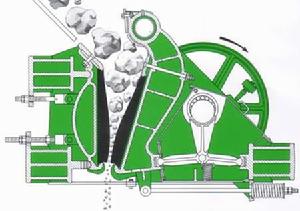
Process
Crushing is the first step in converting shot rock or demolition rubble into usable products, by taking large rocks and breaking them into smaller pieces. Crushing is sometimes continued until only the sand-like 'fines' remain, and in mining applications it is usually followed by milling. At some operations, all the crushing is accomplished in one step, by a single crusher. At other operations, crushing is done in two or more steps, with a primary crusher that is followed by a secondary crusher, and sometimes a tertiary or even quaternary crusher. Each crusher is designed to work with a certain maximum size of raw material, and often delivers its output to a screening machine which sorts and directs the product for further processing.
In operation, the raw material (of various sizes) is usually delivered to the primary crusher's hopper by dump trucks, excavators or wheeled front-end loaders. A feeder device such as a conveyor or vibrating grid controls the rate at which this material enters the crusher, and often contains a preliminary screening device which allows smaller material to bypass the crusher itself, thus improving efficiency. Primary crushing reduces the large pieces to a size which can be handled by the downstream machinery.
Types
jaw crusher
The jaw crusher squeezes rock between two ridged surfaces (jaws) which taper to form a funnel. In most designs one jaw is fixed while the other oscillates at a rate of somewhere around 3 times a second. Raw material enters the jaw crusher from the top. Pieces of rock that are larger than the opening at the bottom of the jaw lodge between the two metal plates of the jaw, and the motion of the oscillating jaw against the fixed jaw continues to pound the lodged pieces until they are broken into pieces small enough to drop through the opening at the bottom.
impact crusher
There are two types of impact crushers. The Horizontal Shaft Impactor (HSI) and the Vertical Shaft Impactor (VSI).
HSI CRUSHERS
The HSI crushers break rock by impacting the rock with hammers that swing on a rotating shaft. The practical use of HSI crushers is limited to soft materials and non abrasive materials, such as limestone, phosphate, gypsum, weathered shales.
Capital-Saving Jaw Crusher
This type of Cap-Saving Jaw Crusher as the newest generation ,adopting the advanced technology by optimizing the mechanical performance and working principal, has been highly approved for jaw crusher'slower power consumption, high crushing ratio and remarkable convenience in maintains during thousand times of testing running experimentations,which brings greater economical advantage for the user in consideration of low capital cost solution, optimum performance, while ensuing the lowest operation cost for per ton for a wide range of material and application.This jaw crusher is widly used in crushing plant as prepary crusher for material of hardness 400Mpa.
cone crusher
A cone crusher is similar in operation to a gyratory crusher, with less steepness in the crushing chamber and more of a parallel zone between crushing zones. A cone crusher breaks rock by squeezing the rock between an eccentrically gyrating spindle, which is covered by a wear resistant mantle, and the enclosing concave hopper, covered by a manganese concave or a bowl liner. As rock enters the top of the cone crusher, it becomes wedged and squeezed between the mantle and the bowl liner or concave. Large pieces of ore are broken once, and then fall to a lower position (because they are now smaller) where they are broken again. This process continues until the pieces are small enough to fall through the narrow opening at the bottom of the crusher.
Technology
For the most part advances in crusher design have moved slowly. Jaw crushers have remained virtually unchanged for sixty years. More reliability and higher production have been added to basic cone crusher designs that have also remained largely unchanged. Increases in rotating speed, have provided the largest variation. For instance, a 48 inch (120 cm) cone crusher manufactured in 1960 may be able to produce 170 tons/hr of crushed rock, whereas the same size cone manufactured today may produce 300 tons/hr. These production improvements come from speed increases and better crushing chamber designs.
The largest advance in cone crusher reliability has been seen in the use of hydraulics to protect crushers from damage from uncrushable objects entering the crushing chamber. Foreign objects, such as steel, can cause extensive damage to a cone crusher, and more costs in lost production. The advance of hydraulic relief systems has greatly reduced downtime and improved the life of these machines.
